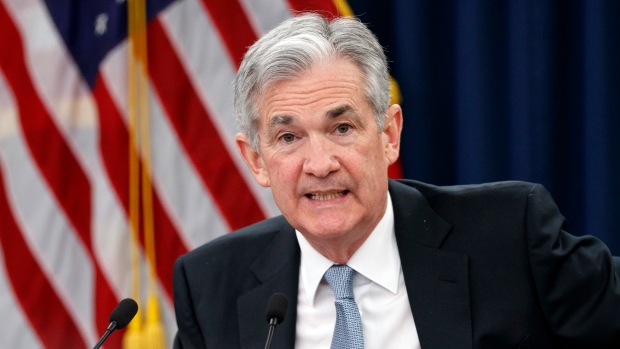Mar 21, 2018
U.S. Fed raises rates, as Powell signals confidence in economy
, Bloomberg News

Federal Reserve officials, meeting for the first time under Chairman Jerome Powell, raised the benchmark lending rate a quarter-point and forecast a steeper path of hikes in 2019 and 2020, citing an improving economic outlook. Policy makers continued to project a total of three increases this year.
“The economic outlook has strengthened in recent months,” the policy-setting Federal Open Market Committee said in a statement Wednesday in Washington. Officials repeated previous language that they anticipate “further gradual adjustments in the stance of monetary policy.”
The upward revision in their rate path suggests Fed officials are looking through soft first-quarter economic reports and expect a lift this year and next from tax cuts passed by Republicans in December. Financial conditions have tightened since late January as investors look for signs that the central bank might raise rates at a faster pace, while forecasters predict stronger U.S. growth and tight labor markets.
“The job market remains strong, the economy continues to expand, and inflation appears to be moving toward the FOMC’s 2 per cent longer running goal,” Powell said in a press conference that he kept somewhat shorter than those conducted by his predecessor, Janet Yellen. Powell said he’s “carefully considering” expanding the number of such briefings where he explains Fed decision, cautioning that he wanted to be sure that didn’t send any signals about the path of policy.
The vote to lift the federal funds rate target range to 1.5 per cent to 1.75 per cent was a unanimous 8-0.
The latest set of quarterly forecasts forecasts showed that policy makers were divided over the outlook for the benchmark interest rate in 2018. Seven officials projected at least four quarter-point hikes would be appropriate this year, while eight expected three or fewer increases to be warranted.
In the briefing with reporters, Powell hued to the FOMC plan for gradual rate increases. While generally upbeat about the economy’s prospects, he also said the Trump administration’s trade policy has become a concern for businesses.
In the forecasts, U.S. central bankers projected a median federal funds rate of 2.9 per cent by the end of 2019, implying three rate increases next year, compared with two 2019 moves seen in the last round of forecasts in December. They saw rates at 3.4 per cent in 2020, up from 3.1 per cent in December, according to the median estimate.
The S&P 500 Index of U.S. stocks were higher after Powell spoke, while the yield on 10-year U.S. Treasury notes were around 2.89 per cent, little changed from Tuesday. The Bloomberg Dollar Spot Index was lower.
- Trade war between U.S. and China would hurt both, but not fatally, economists say
- Trudeau remains optimistic on NAFTA; Lighthizer says auto plan 'finally starting to converge'
- G20 pushes for free trade as U.S. vows to defend interests
MORE ON THE U.S. ECONOMY
Inflation Pickup
In another change to the statement, the Fed said inflation on an annual basis is “expected to move up in coming months,” after saying “move up this year” in the January statement. Price gains are still expected to stabilize around the Fed’s 2 per cent target over the medium term, the FOMC said.
The central bank’s preferred price gauge rose 1.7 per cent in the 12 months through January and officials projected it to rise to 2 per cent in 2019 and hit 2.1 per cent the following year, the latest estimates showed. The estimates for inflation excluding food and energy, which officials see as a better way to gauge underlying price trends, rose to 2.1 per cent in 2019 and 2020 from 2 per cent seen in December.
“Job gains have been strong in recent months, and the unemployment rate has stayed low,” the FOMC said. The statement said that household spending and business investment “have moderated” from strong fourth-quarter readings.
The statement also repeated previous language that “near-term risks to the economic outlook appear roughly balanced.”
Supply, Demand
The Fed’s goal is to keep supply and demand in balance in the economy amid a tight labor market, without lifting borrowing costs so quickly that the economy stalls.
Officials have had to factor in the impact of fiscal stimulus signed by President Donald Trump since their previous projections.
The median estimate for economic growth this year rose to 2.7 per cent from 2.5 per cent in December, signaling confidence in U.S. consumers despite recent weak readings on retail sales that have pushed down tracking estimates of first-quarter activity. The 2019 estimate rose to 2.4 per cent from 2.1 per cent.
The committee’s forecast for the long-run sustainable growth rate of the economy was unchanged at 1.8 per cent, suggesting policy makers are still skeptical of the effect of tax cuts on the economy’s capacity for growth. The 2020 gross domestic product growth median projection was also unchanged at 2 per cent.
While U.S. unemployment of 4.1 percent is the lowest since 2000, wage growth has remained moderate and inflation has been below the Fed’s target for most of the last five years.
The median projection for the long-run fed funds rate ticked up to 2.9 percent from 2.8 percent in December. The Fed had been gradually reducing its estimate of the long-run neutral fed funds rate since it began publishing its calculations in January 2012.
Estimates for the long-run sustainable unemployment rate also declined, pushing the median down to 4.5 percent from 4.6 percent seen in December.
